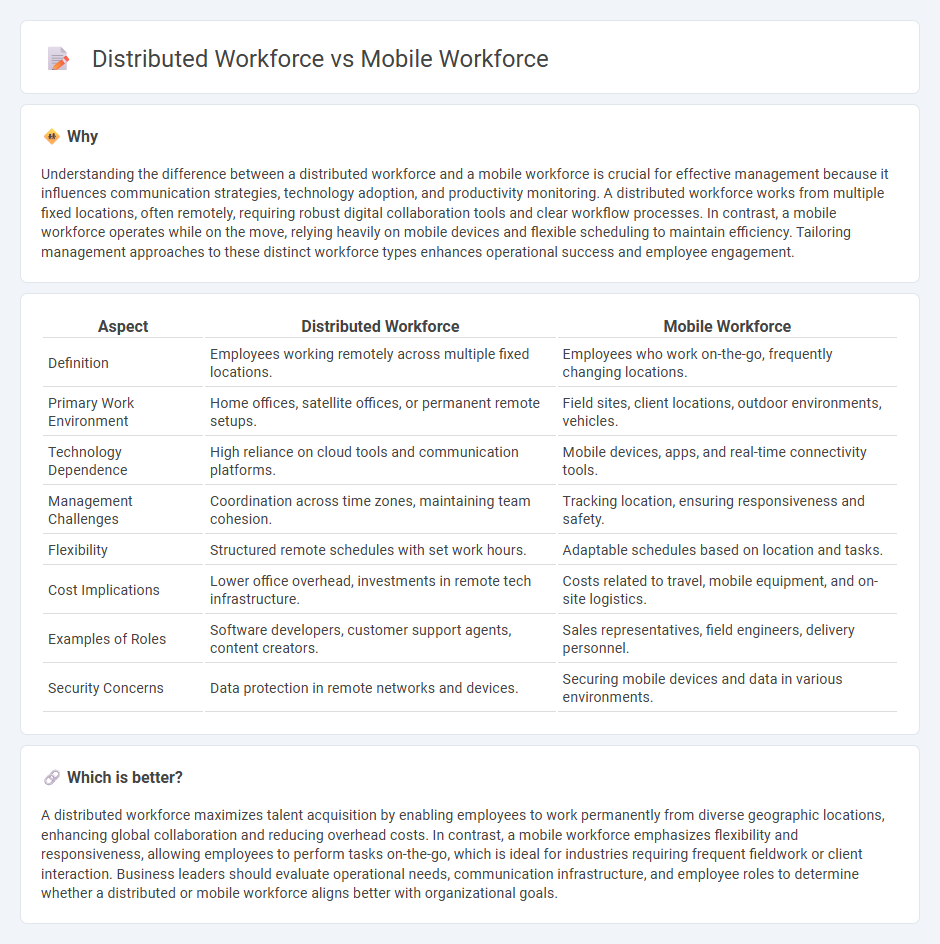
Distributed workforce comprises employees working from various fixed locations, collaborating through digital tools to achieve organizational goals. Mobile workforce involves professionals who perform tasks while traveling or working remotely, relying heavily on mobile technology for communication and productivity. Explore the differences and benefits of both workforce models to optimize your business strategy.
Why it is important
Understanding the difference between a distributed workforce and a mobile workforce is crucial for effective management because it influences communication strategies, technology adoption, and productivity monitoring. A distributed workforce works from multiple fixed locations, often remotely, requiring robust digital collaboration tools and clear workflow processes. In contrast, a mobile workforce operates while on the move, relying heavily on mobile devices and flexible scheduling to maintain efficiency. Tailoring management approaches to these distinct workforce types enhances operational success and employee engagement.
Comparison Table
| Aspect | Distributed Workforce | Mobile Workforce |
|---|---|---|
| Definition | Employees working remotely across multiple fixed locations. | Employees who work on-the-go, frequently changing locations. |
| Primary Work Environment | Home offices, satellite offices, or permanent remote setups. | Field sites, client locations, outdoor environments, vehicles. |
| Technology Dependence | High reliance on cloud tools and communication platforms. | Mobile devices, apps, and real-time connectivity tools. |
| Management Challenges | Coordination across time zones, maintaining team cohesion. | Tracking location, ensuring responsiveness and safety. |
| Flexibility | Structured remote schedules with set work hours. | Adaptable schedules based on location and tasks. |
| Cost Implications | Lower office overhead, investments in remote tech infrastructure. | Costs related to travel, mobile equipment, and on-site logistics. |
| Examples of Roles | Software developers, customer support agents, content creators. | Sales representatives, field engineers, delivery personnel. |
| Security Concerns | Data protection in remote networks and devices. | Securing mobile devices and data in various environments. |
Which is better?
A distributed workforce maximizes talent acquisition by enabling employees to work permanently from diverse geographic locations, enhancing global collaboration and reducing overhead costs. In contrast, a mobile workforce emphasizes flexibility and responsiveness, allowing employees to perform tasks on-the-go, which is ideal for industries requiring frequent fieldwork or client interaction. Business leaders should evaluate operational needs, communication infrastructure, and employee roles to determine whether a distributed or mobile workforce aligns better with organizational goals.
Connection
A distributed workforce consists of employees working from various geographical locations, while a mobile workforce refers to employees who perform tasks on the move using mobile technology. Both models leverage cloud-based collaboration tools, real-time communication platforms, and secure remote access to enhance productivity and flexibility. Integration of these workforces enables organizations to optimize resource allocation, support dynamic work environments, and improve overall operational efficiency.
Key Terms
Remote Work
Mobile workforce refers to employees who perform job duties on the go, often using smartphones, tablets, and laptops, enabling productivity outside traditional office settings. Distributed workforce consists of team members working from various geographic locations, relying heavily on digital communication and collaboration tools to maintain workflow continuity. Explore further to understand how each model impacts remote work efficiency and organizational culture.
Collaboration Tools
Collaboration tools for a mobile workforce typically prioritize seamless access across various devices and locations, enabling real-time communication and project management on the go. Distributed workforce collaboration tools emphasize robust, scalable platforms that support asynchronous workflows and secure file sharing among geographically dispersed teams. Explore our comprehensive guide to discover the best collaboration tools tailored for your workforce model.
Talent Localization
Mobile workforce refers to employees who travel frequently or work from various locations temporarily, enhancing flexibility in talent deployment. Distributed workforce consists of employees permanently based in diverse geographic locations, enabling deep talent localization and access to region-specific expertise. Explore how optimizing talent localization through mobile and distributed workforce models can drive strategic advantage in your organization.
Source and External Links
What is a Mobile Workforce? - IBM - A mobile workforce consists of employees not tied to a single physical location, connected by mobile devices and technology, enabling work from various locations beyond traditional offices, including hybrid and deskless workers across many industries.
What is a Mobile Workforce in Field Service? - Salesforce - A mobile workforce includes employees and contractors working outside of traditional offices, enabling businesses to expand geographically, improve response times, optimize resources, and adapt flexibly using management software powered by AI for scheduling and communication.
All about Mobile Workforce - Definition, Challenges, Benefits and more - The mobile workforce operates via mobile devices, offering employees flexible work hours and locations, while improving corporate productivity and customer service by enabling real-time communication and better data collection.
 dowidth.com
dowidth.com